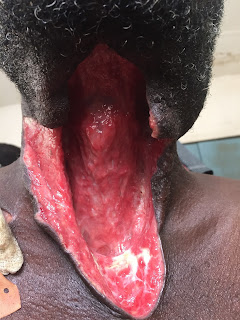At midnight the phone rang. “A woman who just gave birth is bleeding a lot.”
In the OR Staci was performing a curettage to make sure no pieces of placenta were causing the problem. Medications oxytocin and methergine were in. Staci had also verified there were no major lacerations in the birth canal. We then quickly packed the uterus with gauze in an attempt to stop the hemorrhage. This woman had been laboring for days at home after her water broke. Her inflamed uterus was not clamping down like it should. Phillipe, our nurse who performs anesthesia, was infusing another bag of blood.
Something drew my attention. It was the pulse on the oxygen sensor. Her heart rate was 170 beats per minute. My heart sank. Was that real? The last blood pressure (BP) reading was 80/50, was that heart rate true? It was ominous. The BP cuff finished cycling: 60/30. Her life at its end flashed before my eyes. Within minutes she would be dead.
The blood was already pouring out in spite of the gauze packing. I asked Phillipe to run 2 bags of blood at the same time. “We’re doing a hysterectomy.” Opened the kit, threw betadine on her abdomen and began cutting. Her blood pressure was not measurable now. Quick clamp cut tie, clamp cut tie. “Please give more blood, yes, MORE blood!” Phillipe ran to the refrigerator again. Her blood pressure intermittently read at 50/30 when the machine would pick it up. Final clamp, cut, uterus out. Ahhhh, breathe…. bleeding stopped.
The transfusion total was 9 units of blood.
The husband was more educated than many of our patients. He was overjoyed when he heard his wife was alive. He understood we had to take out the uterus and said, “Whatever it took to save her, thank you.”
Walking back to our house in the dark morning hours a flood of emotion overtook me. Her life, falling precipitously, was caught just in time. She is alive. People like the Netteburgs, by their sweat and tears, have developed the only blood bank in this part of the country. People hate donating blood here because it diminishes their “force” to work in the fields. However, every elective surgery patient must have a family member donate a unit of blood. We explain that if the patient needs it during surgery then we give it. If it is not needed during the surgery, we use it for emergencies.
Consequently, every hernia we’ve worked hard to repair this month was another life-saving unit of blood. The cost of generators, fuel, and the mechanic to keep electricity working (most of the time) is beyond what most hospitals in Chad can afford. We have the luxury of keeping our blood bank refrigerator running.
Our transfusion protocol includes a built-in 1:1:1 ratio of red blood cells, platelets, and plasma. This has been shown to reduce hemorrhage in numerous trauma studies. Even many rural trauma centers in the US have not yet achieved this goal. We don’t separate the components. Consequently, all of it is whole blood, and that’s what we give.
This woman will raise her kids. People are not surprised when a mother dies in childbirth here. It is so common. Many children grow up without the mother they lost in childbirth. Not for this family though. She is alive!








